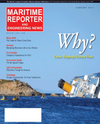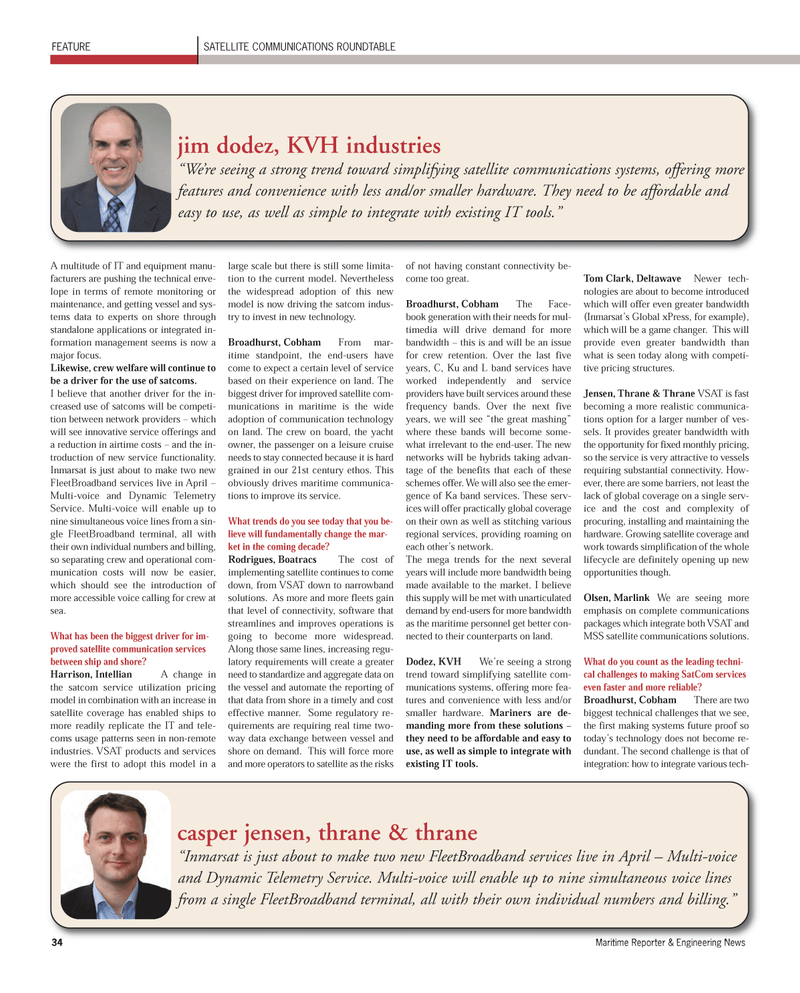
Page 34: of Maritime Reporter Magazine (February 2012)
Cruise Shipping Annual
Read this page in Pdf, Flash or Html5 edition of February 2012 Maritime Reporter Magazine
34Maritime Reporter & Engineering News A multitude of IT and equipment manu-facturers are pushing the technical enve- lope in terms of remote monitoring ormaintenance, and getting vessel and sys- tems data to experts on shore through standalone applications or integrated in- formation management seems is now a major focus. Likewise, crew welfare will continue to be a driver for the use of satcoms. I believe that another driver for the in- creased use of satcoms will be competi-tion between network providers ? which will see innovative service offerings and a reduction in airtime costs ? and the in-troduction of new service functionality. Inmarsat is just about to make two new FleetBroadband services live in April ? Multi-voice and Dynamic Telemetry Service. Multi-voice will enable up to nine simultaneous voice lines from a sin- gle FleetBroadband terminal, all withtheir own individual numbers and billing, so separating crew and operational com- munication costs will now be easier, which should see the introduction ofmore accessible voice calling for crew at sea.What has been the biggest driver for im- proved satellite communication services between ship and shore? Harrison, IntellianA change inthe satcom service utilization pricingmodel in combination with an increase insatellite coverage has enabled ships to more readily replicate the IT and tele-coms usage patterns seen in non-remoteindustries. VSAT products and services were the first to adopt this model in a large scale but there is still some limita- tion to the current model. Nevertheless the widespread adoption of this new model is now driving the satcom indus- try to invest in new technology. Broadhurst, Cobham From mar- itime standpoint, the end-users have come to expect a certain level of service based on their experience on land. The biggest driver for improved satellite com- munications in maritime is the wideadoption of communication technologyon land. The crew on board, the yacht owner, the passenger on a leisure cruise needs to stay connected because it is hardgrained in our 21st century ethos. This obviously drives maritime communica- tions to improve its service. What trends do you see today that you be- lieve will fundamentally change the mar- ket in the coming decade? Rodrigues, BoatracsThe cost ofimplementing satellite continues to comedown, from VSAT down to narrowband solutions. As more and more fleets gain that level of connectivity, software that streamlines and improves operations is going to become more widespread.Along those same lines, increasing regu- latory requirements will create a greaterneed to standardize and aggregate data on the vessel and automate the reporting of that data from shore in a timely and costeffective manner. Some regulatory re- quirements are requiring real time two- way data exchange between vessel and shore on demand. This will force more and more operators to satellite as the risksof not having constant connectivity be- come too great. Broadhurst, Cobham The Face- book generation with their needs for mul-timedia will drive demand for more bandwidth ? this is and will be an issuefor crew retention. Over the last five years, C, Ku and L band services have worked independently and service providers have built services around these frequency bands. Over the next five years, we will see ?the great mashing?where these bands will become some-what irrelevant to the end-user. The new networks will be hybrids taking advan- tage of the benefits that each of these schemes offer. We will also see the emer- gence of Ka band services. These serv- ices will offer practically global coverage on their own as well as stitching various regional services, providing roaming on each other?s network. The mega trends for the next several years will include more bandwidth beingmade available to the market. I believe this supply will be met with unarticulateddemand by end-users for more bandwidthas the maritime personnel get better con-nected to their counterparts on land.Dodez, KVHWe?re seeing a strong trend toward simplifying satellite com- munications systems, offering more fea- tures and convenience with less and/or smaller hardware. Mariners are de- manding more from these solutions ? they need to be affordable and easy to use, as well as simple to integrate withexisting IT tools. Tom Clark, Deltawave Newer tech- nologies are about to become introducedwhich will offer even greater bandwidth (Inmarsat?s Global xPress, for example), which will be a game changer. This will provide even greater bandwidth than what is seen today along with competi-tive pricing structures. Jensen, Thrane & Thrane VSAT is fast becoming a more realistic communica-tions option for a larger number of ves- sels. It provides greater bandwidth with the opportunity for fixed monthly pricing, so the service is very attractive to vessels requiring substantial connectivity. How- ever, there are some barriers, not least the lack of global coverage on a single serv- ice and the cost and complexity of procuring, installing and maintaining thehardware. Growing satellite coverage and work towards simplification of the whole lifecycle are definitely opening up new opportunities though.Olsen, MarlinkWe are seeing more emphasis on complete communicationspackages which integrate both VSAT and MSS satellite communications solutions. What do you count as the leading techni- cal challenges to making SatCom services even faster and more reliable? Broadhurst, Cobham There are two biggest technical challenges that we see,the first making systems future proof so today?s technology does not become re- dundant. The second challenge is that of integration: how to integrate various tech- SATELLITE COMMUNICATIONS ROUNDTABLE FEATURE jim dodez, KVH industries ?We?re seeing a strong trend toward simplifying satellite communications systems, offering more features and convenience with less and/or smaller hardware. They need to be affordable and easy to use, as well as simple to integrate with existing IT tools.? casper jensen, thrane & thrane?Inmarsat is just about to make two new FleetBroadband services live in April ? Multi-voice and Dynamic Telemetry Service. Multi-voice will enable up to nine simultaneous voice lines from a single FleetBroadband terminal, all with their own individual numbers and billing.? MR Feb.12 # 5 (34-41):MR Template 2/7/2012 10:36 AM Page 34

 33
33

 35
35
